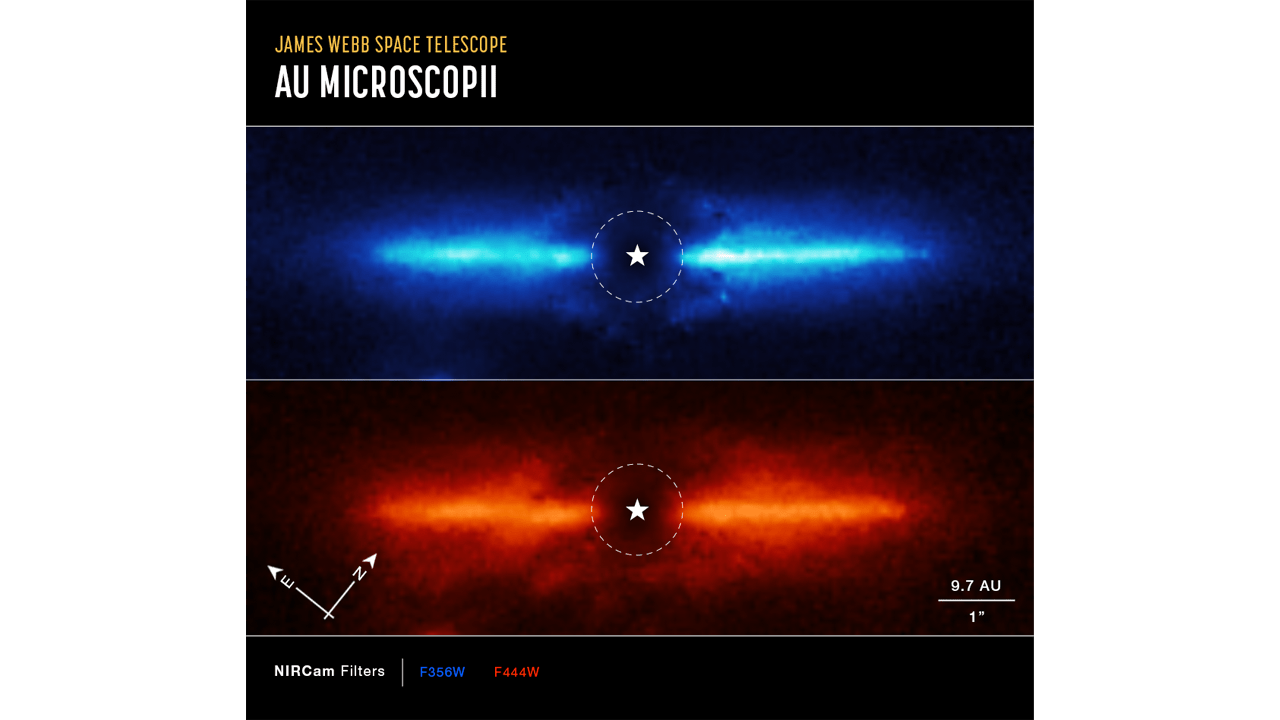AU Microscopii is a small red dwarf star about 32 light-years away. It’s far too dim for the unaided human eye, but that doesn’t diminish its appeal. The star has at least two exoplanets and hosts a circumstellar debris disk.
It’s also young, only about 23 million years old, and it’s the second-closest pre-main sequence star to Earth. The JWST recently imaged the star and its surroundings and found something surprising.
These observations were part of the JWST’s Guaranteed Time Observations (GTO.) A segment of the GTO is aimed at finding exoplanets around dim red dwarfs. It’s easier to spot planets around dimmer stars because the starlight doesn’t blind instruments to the faint dips in light from planets transiting in front of stars. That’s especially important in this case because the observers were looking for planets on very wide orbits, which our exoplanet-searching efforts have struggled to locate.
The debris disk surrounding AU Microscopii is made of debris from colliding planetesimals. It’s dense and difficult to see into, but the JWST’s powerful infrared instruments can peer inside all that dust. This is uncharted territory and once again shows how valuable the JWST is.
These observations are part of new research presented at the 241ST Meeting of the American Astronomical Society in Seattle, Washington. The lead author is Kellen Lawson from NASA’s Goddard Space Flight Center. Lawson is part of a team developing a new program to find planets on wide orbits around low-mass stars, which has been challenging.

“A debris disk is continuously replenished by collisions of planetesimals. By studying it, we get a unique window into the recent dynamical history of this system,” said Lawson.
It’s not just the disk but the system as a whole that makes it a desirable target for observations.
“This system is one of the very few examples of a young star, with known exoplanets and a debris disk that is near enough and bright enough to study holistically using Webb’s uniquely powerful instruments,” said Josh Schlieder of NASA’s Goddard Space Flight Center, principal investigator for the observing program and a study co-author.
The JWST’s NIRCam (Near-Infrared Camera) played the leading role in this work. NIRCam has several coronagraphs, instruments that mask the light of a star so that NIRCam can better image the region surrounding the star. By employing a coronograph, NIRCam could observe the debris disk within five astronomical units of the star, or about the same as Jupiter’s distance from the Sun in our Solar System. The disk’s edge-on aspect aided the observations.
In what’s becoming a familiar refrain, the JWST exceeded expectations.

IMAGE PROCESSING: Alyssa Pagan (STScI)
The top blue image is a shorter wavelength than the bottom red image, and it’s also brighter. That means the disk contains lots of fine dust that can scatter shorter wavelengths of light more efficiently. This agrees with other studies of the star that showed insufficient radiation pressure to blow the dust away.
“Our first look at the data far exceeded expectations. It was more detailed than we expected. It was brighter than we expected. We detected the disk closer in than we expected. We’re hoping that as we dig deeper, there’s going to be some more surprises that we hadn’t predicted,” stated Schlieder.
The team also found that the disk contains fast-moving clumps of material. In an exchange with Universe Today, lead author Lawson talked about the significance of the clumps. “The ‘fast-moving clumps’ were first reported in 2015 and are likely made of the same material as the rest of the disk,” Lawson said. “These appear to be clouds of dust being accelerated to high velocity by some yet-unknown driver. One hypothesis favoured in the Boccaletti et al. works is that something like a planet within the disk could be interacting with disk material to produce the clumps.”
Lawson also said that he’s unaware of any other disk with clumps like these and that their study could help test this hypothesis.

Observing AU Microscopii’s dusty disk is an achievement, but it’s not the primary purpose of the work. The main objective is to look for giant planets on wide orbits like the gas giants and ice giants in our Solar System. Most of the exoplanets we’ve found are much closer to their stars. That’s not necessarily because our Solar System is rare, and others don’t have planets on wide orbits. It’s more likely because of the detection bias in our exoplanet-hunting methods. But the JWST’s power could shift that dynamic.
“This is the first time that we really have sensitivity to directly observe planets with wide orbits that are significantly lower in mass than Jupiter and Saturn. This really is new, uncharted territory in terms of direct imaging around low-mass stars,” explained Lawson.
Lawson’s and his colleagues’ paper is still under review. But once it’s published, it’ll be another instance of the JWST’s power to address pertinent questions in astronomy.

